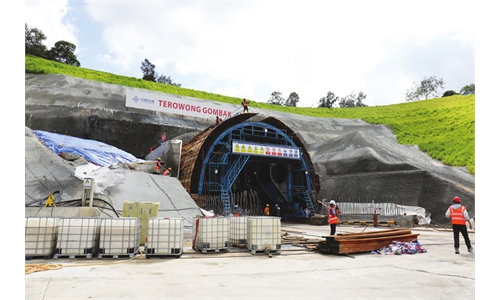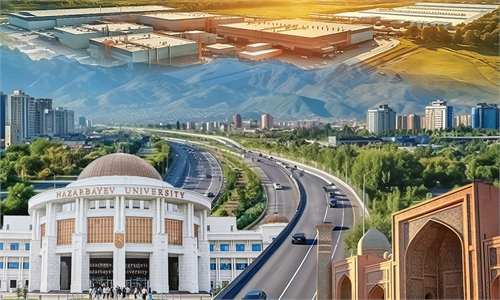ARTS / CULTURE & LEISURE
BRI's benefits recorded in evolution of documentaries

Illustration: Liu Xiangya/Global Times
In 2013, Chinese President Xi Jinping raised the initiative of jointly building a "Silk Road Economic Belt" and a "21st Century Maritime Silk Road," with the aim of establishing a community with shared interests, shared responsibilities and a shared future, characterized by peace and cooperation, openness and inclusiveness, mutual learning and mutual benefits.
Over the past decade, the Belt and Road Initiative (BRI) has strengthened the bonds among member countries, creating a more robust and reliable circle of friends. It has also constructed new bridges for economic, trade, and cultural exchanges, enhancing global connectivity and advancing the construction of a community with a shared future for humanity.
During this time, BRI-themed documentaries have continuously emerged as a "mirror of the times," becoming important mediums and artistic forms for visually documenting the deep historical heritage, the vibrant contemporary practices and the envisioned future development of the BRI.
Over the past 10 years of the BRI, with roughly five-year intervals as reference points, documentaries related to the initiative have exhibited distinct characteristics corresponding to different stages.
The first wave of BRI documentaries, released shortly after the initiative's launch, took a macroscopic approach. They offered sweeping narratives and grand perspectives aimed at conveying the overarching vision of the BRI. These early documentaries provided a broad overview of the initiative's goals and global implications, which were instrumental in introducing the grand vision of the BRI to the world.
As the BRI transitioned from vision to reality, relevant documentaries adopted a micro-level and detailed approach, focusing on individual stories of people, industries, and companies. For instance, Personal Tales Along the Silk Road highlighted the selfless dedication of archaeologists and cultural workers, connecting their work to the vast history of the Silk Road. My Youth Is On The Silk Road showcased young people striving for their dreams in BRI countries, emphasizing their contributions to local infrastructure and communities.
These micro-level narratives brought the grand vision of the BRI down to a relatable, human scale and adhered to a "people-centric" approach, portraying the lives and work of ordinary people and making the BRI more tangible and relatable.
As content became more refined and commonplace, BRI documentaries embraced a more concise and focused format. Micro-documentaries adopted shorter, web-friendly episodes to tell specific stories of cooperation and mutual benefit along the BRI.
Chang'an Meets Rome employs a parallel perspective akin to Tale of Two Cities. In each brief five-minute episode, it delves into the civilization legends hidden behind the two pivotal cities, Chang'an and Rome, which represent the eastern and western starting points of the Silk Road.
These micro-documentaries brought the spirit of the Silk Road to life through bite-sized narratives, catering to the demands of the "micro-era."
The BRI is not a solitary endeavor but a symphony of cooperation among nations. Similarly, BRI documentaries began to incorporate narratives from international participants, shifting from a single perspective to a more inclusive approach.
In recent years, BRI documentaries have invited international voices to share their experiences and perspectives. Maritime Silk Road - Birth of the Global Economy featured the presence of US filmmaker Jeffrey Lehman, who experiences crucial locations along the Maritime Silk Road, including its origins, ports, and historical sites.
This shift toward inclusivity allowed BRI documentaries to move from a "monologue" to a "dialogue." It created a diverse narrative perspective that reflects the rich tapestry of the BRI's global impact. This approach also aligned with the BRI's principles of extensive consultation, joint contribution and shared benefits.
BRI documentaries have also undergone significant changes in their production techniques. Building upon the foundation of factual shooting and explanatory narratives, they have diversified their expressive techniques, incorporating elements of dramatization and special effects to infuse their works with richer artistic and cultural value.
Firstly, these documentaries have adopted narrative techniques typically found in storytelling. While respecting historical accuracy, they adopted cinematic techniques, such as actor performances and scene reenactments, to bring historical events to life.
Some utilize CG effects and data visualization to illustrate complex visuals and information. Shared Future used map animations to visualize BRI data and routes, providing a clearer understanding of the initiative's scope. These techniques expanded the visual storytelling capabilities of BRI documentaries.
In terms of narrative structure, BRI documentaries used multiple storytelling techniques, such as polyphonic narration, parallel narration and multi-line narration, to vividly depict the challenges and achievements of BRI construction. These narrative innovations added drama and artistry to the documentaries while catering to the aesthetic preferences of a diverse audience.
As the BRI scope and influence continue to increase, BRI-themed documentaries should enhance their reach and effectiveness. First, they should promote collaboration among various stakeholders, both domestically and internationally. Second, they should emphasize shared values and interests along the BRI, finding common ground to tell stories that resonate with a global audience. Third, they should tailor content to the diverse needs of different regions and cultures, ensuring precise and varied dissemination. Last, they should focus on people, highlighting the tangible benefits of the BRI for individuals and fostering empathy through relatable narratives.
The author is an associate professor with the Communication University of China. life@globaltimes.com.cn



